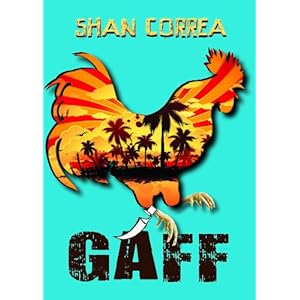The combatants, aptly referred to as gamecocks, are specially bred birds, conditioned for increased stamina and strength. The comb and wattle are cut off in order to meet show standards of the American Gamefowl Society and the Old English Game Club and to prevent freezing in colder climates. Cocks possess congenital aggression toward all males of the same species. Cocks are given the best of care until near the age of two years old. They are conditioned, much like professional athletes prior to events or shows. Wagers are often made on the outcome of the match. While not all fights are to the death, the cocks do endure physical trauma that may result in death. Cockfighting was at one time considered to be an accepted, traditional sporting event in the United States. . . . In some regional variations, the birds are equipped with either metal spurs (called gaffs) or knives, tied to the leg in the area where the bird’s natural spur has been partially removed. ~Wikipedia, Cockfight
 Yes, I’ve heard of cockfighting before. No, I’ve never seen a cockfight (thank goodness). I thought it was a mainly rural/Hispanic sort of thing. I had no idea cockfighting was big in Hawaii, where the book Gaff by Shan Correa is set. In the story, thirteen year old Paul Silva and his friend Sal Salvador are fascinated by the roosters their fathers raise for sale. Then, when the two boys actually attend their first cockfight, Paul is horrified by the violence to the beautiful birds, and he vows to find a way for his father to make a living that doesn’t involve training birds for fighting. Unfortunately, that way may involve moving the family away from their Hawaiian country home to a condominium. Is it worth it when someone else will take their place in the cockfighting and breeding business anyway?
Yes, I’ve heard of cockfighting before. No, I’ve never seen a cockfight (thank goodness). I thought it was a mainly rural/Hispanic sort of thing. I had no idea cockfighting was big in Hawaii, where the book Gaff by Shan Correa is set. In the story, thirteen year old Paul Silva and his friend Sal Salvador are fascinated by the roosters their fathers raise for sale. Then, when the two boys actually attend their first cockfight, Paul is horrified by the violence to the beautiful birds, and he vows to find a way for his father to make a living that doesn’t involve training birds for fighting. Unfortunately, that way may involve moving the family away from their Hawaiian country home to a condominium. Is it worth it when someone else will take their place in the cockfighting and breeding business anyway?
The Wikipedia article goes on to say that cockfighting is illegal in all fifty states of the United States. In forty states and in D.C. it is illegal to be a spectator at a cockfight. However, it is not illegal to train birds for fighting or to raise them for the purpose of being fighting birds.
Correa’s book has descriptions just vivid enough to convey the nastiness of the “sport” but it remains appropriate for a middle grade audience. If the ending is a little bit too hopeful, it’s hard to find fault when I was rooting for Paul and his family to find the perfect way out of the cockfighting business and into a better way of making a living. The detailed descriptions of life in Hawaii and the occasional taste of pidgin English gave the book a regional flavor that was lots of fun. And the story does a good job of showing the different perspectives of the characters on cockfighting without either condoning the violence and cruelty or preaching against it.
I wasn’t sure going in that I would like this one, but I did. I liked the way the parents and family were involved in all aspects of the story. And I also liked the way the Catholic faith of the families in the story became a natural part of their lives and of the the plot of the the novel.
I would end this review with my “other takes” feature, but the only place I can find this book even mentioned is, appropriately enough, at the Hawaii Book Blog. And even there it hasn’t been reviewed yet. Hawaiians and others should love this island story of a boy growing up and learning to trust his own convictions.
Pingback: Touring the USA with Cybils Nominees : Semicolon
Thanks for the mention! This book (“Gaff”) has been nominated for the Ka Palapala PoÊ»okela Award in the category of Excellence in “Aloha from across the Sea,” which is for HawaiÊ»i-themed books published outside of the state.
I’d review it, but unfortunately I still haven’t read it yet. It’s one of many local books on my to-read list. I think Misty (my co-blogger) read it, or most of it–I’d have to check with her.
Mahalo!